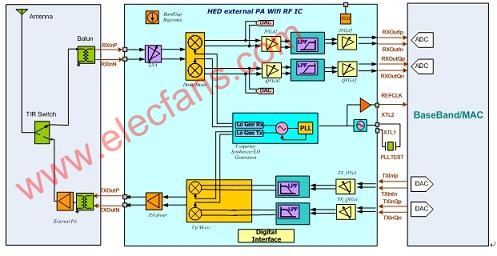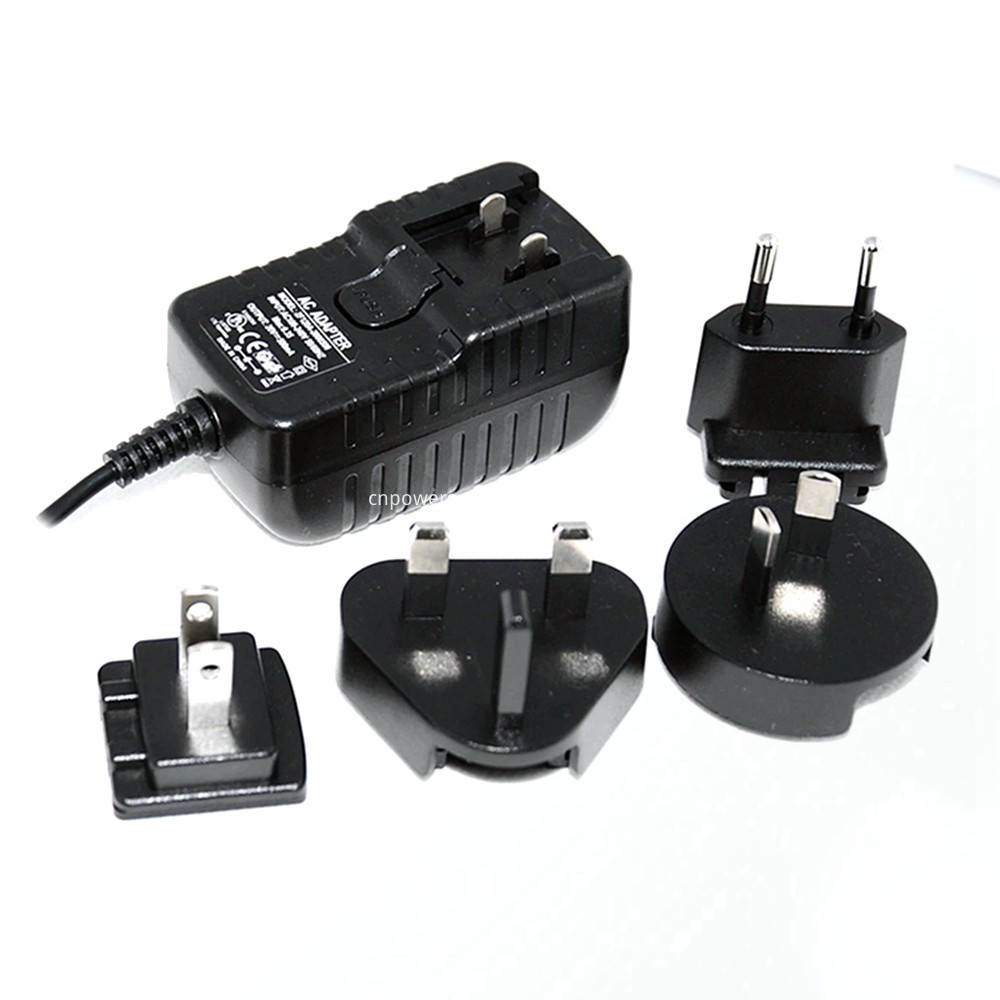In order to meet people's higher requirements for communication speed and quality, WLAN's 802.11 standard has also continuously evolved, and has experienced the development process from b, a, g to n. The 802.11b in the 2.4GHz band is the earliest WLAN protocol, using direct sequence spread spectrum technology and QPSK modulation, and the communication data rate can be up to 11Mbps; the subsequently proposed 802.11a protocol is defined in the 5GHz band and uses 52 subcarrier orthogonal frequencies Division Multiplexing (OFDM) and BPSK, QPSK, 16-QAM and 64-QAM modulation methods. Depending on the modulation method, the communication data rate varies from 6Mbps to 54Mbps; 802.11g combines the technologies used in the above two standards, defined in the 2.4GHz band, and the highest communication rate is 54Mbps; the latest 802.11n standard uses diversity technology to support multiple The two transceiver channels work simultaneously to improve the communication quality and rate. At the same time, by increasing the channel bandwidth to 40MHz and using up to 114 OFDM subcarriers and higher coding efficiency, the highest communication data rate reaches 150Mbps. For two channels of transceiver System, the data rate can reach 300Mbps. High-speed communication imposes stringent requirements on the performance of the RF transceiver chip. In order to obtain a better received signal-to-noise ratio (SNR) and error margin (EVM), the RF transceiver needs to achieve a lower noise figure, phase noise Level, it also requires smaller I / Q phase and amplitude mismatches, higher bandwidth, and better linearity performance. From the perspective of market demand, more and more WLAN consumer electronics products are used in mobile terminals. These products usually have fierce price competition, and most of them use battery power. Therefore, RF chips are required to have low power consumption and high integration And strong anti-interference ability and other characteristics. Under such requirements, it is extremely difficult to design high-performance RF transceiver chips. Beijing CLP Huada Electronic Design Co., Ltd. (hereinafter referred to as Huada Electronics) has been devoted to the research and development of WLAN core chips and module products for many years. The product applications cover notebooks, USB external wireless network cards, home audio and video, security monitoring , Operator hotspot products, home gateways, industrial applications, intelligent transportation and other fields. Following the successful mass production of three WLAN baseband chips that support both the domestic (WAPI) / international (11i) security standards of the Airquick series (Airquick), BGI has now successfully developed a high-level 802.11b / g / n standard Integrated radio frequency transceiver chip HED09W06RN-1, and on this basis, launched WLAN module products (as shown in Figure 1). HED09W06RN-1 is a high-integration, low-power single-chip WLAN RF transceiver for the mobile terminal market. The chip works in the 2.4GHz band and supports 802.11b / g / n protocol. HED09W06RN-1 adopts CMOS technology and integrates a complete transceiver channel. The transceiver chooses the direct frequency conversion architecture (as shown in Figure 2), without the need for image suppression, reducing the system complexity. The DC deviation related to direct frequency conversion is eliminated by integrating relevant circuit modules in the chip. HED09W06RN-1 takes advantage of its high degree of integration to integrate radio frequency modules such as low noise amplifier (LNA), voltage controlled oscillator (VCO) and power amplifier driver amplifier (PA Driver) into the chip while ensuring transceiver performance. This minimizes the number of external chips required in product development, and also greatly reduces the number of surface-mount components such as resistors and capacitors on the development board, which not only reduces costs, but also simplifies design and improves production yield. The transceiver chip also provides a crystal oscillation frequency calibration circuit, which can use an off-chip crystal instead of a crystal oscillator module to provide a reference clock, further reducing production costs. In addition, good configurability enables the parameters of gain, power consumption, bandwidth, linearity, etc. of all levels of circuits in the chip to be configured through the three-wire serial bus interface, so that the transceiver system can simultaneously support different protocol requirements. HED09W06RN-1 not only has high integration and configurability, but also has good transceiver performance. The noise figure of the receiver is lower than 5dB, and the receiving sensitivity of the 802.11b signal of 1Mbps reaches -95dBm. The receiving EVM can be as low as -32dB. 802.11n has strict requirements on the I / Q phase and amplitude mismatch in the transceiver, and the reason for the I / Q mismatch is the symmetry and consistency of the chip layout. Due to the difference in chip processing technology, I / Q mismatch is usually difficult to eliminate, which will seriously affect the quality of signal transmission and reception. HED09W06RN-1 integrates corresponding circuit modules to complete the correction of I / Q mismatch. These auxiliary modules can correct the leakage of the transmitted local oscillator signal in addition to the transceiver I / Q mismatch, which will be caused by various non-ideal The deterioration of transceiver performance caused by factors is reduced to a minimum. HED09W06RN-1 adopts 7mm × 7mm QFN48 package, compared with the industry's existing WLAN radio frequency chip solution, not only the chip area is smaller, the number of external components is also greatly reduced, the overall design scheme complexity is greatly reduced, so that the product cost of system design manufacturers The budget has been significantly reduced, significantly improving the competitiveness of product solutions. Relying on its strong technical research and development capabilities, Huada Electronics can provide customers with RF chip-based product solutions. And to give full range of technical support to the problems arising in the product development process.
Exchangeable AC plug models power adapter,interchangeable plug power adapter,multiple plug power adapter,interchangeable plug power supply 5V 7V 9V 12V 15V 16V 19V 21V 25V 30V 36V.
The 15V interchangeable plug power adapter was made from high quality fireproof ABS+PC with
highlighted surface treatment, featuring great grip, high strength, anti-shock,
bumps-resistant,to ensure high quality.This 15v Detachable Plug Power Adapter comes with built-in intelligent IC and fuse, to offer protection against over-charge,over-voltage,over-heating that ensures a safe use.
15v Detachable Plug Power Adapter 15 Volt Adapter,Ac Adapter 15V,15V Ac Adapter,15V Dc Power Adapter Shenzhen Juyuanhai Electronic Co., Ltd. , https://www.powersupplycn.com
Figure 1: WLAN module real picture. 
Figure 2: HED09W06RN-1 chip architecture diagram. 
WLAN radio frequency solution based on chip HED09W06RN-1
WLAN, as the most widely used technology in wireless local area network communication, has long been extended from the PC / notebook market to audio and video, handheld terminals, wireless city hotspot coverage, industrial applications and other aspects of people's work and life, bringing people into convenient intelligence Wireless era.